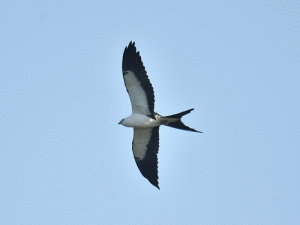
Swallow-tailed Kites are one of the many bird species that migrate during the fall. -Photo: Joe Kennedy
One of the best sensations on earth is the first crisp breeze of fall hitting your face. While I’m not sure when we Texans will experience that this year, the Fall Equinox is upon us nonetheless. One of my favorite aspects of fall is watching animals behave in ways unique to the season.
Like in spring, many animals become more active compared to their summer and winter behaviors. Many are preparing for the winter, taking advantage of the bountiful food and resources summer has provided.
Some animals that live in cold environments may hibernate in the winter. This is when an animal’s heart rate slows down, their body temperature drops, and their breathing becomes shallow. This allows them to conserve energy so they can survive during the harsh winter. Animals prepare for hibernation by gorging on as much food as possible, to gain as many layers of fat as they can to keep warm. In Texas, due to our mild winters, we have very few true hibernators. Some animals that hibernate in North America include black bears, groundhogs, chipmunks, salamanders, and certain bats.
Many birds, bats (some migrate while others hibernate), monarch butterflies, and other animals migrate south to escape the cold and find food and resources in warmer climates.
Many animals have other adaptations to survive winter. For example, white-tailed deer grow thicker coats with guard hairs and an undercoat, and they retain fat to keep warm. Squirrels are another example. We’ve all seen squirrels with chubby cheeks, using them to store as many nuts as possible for winter. Fun fact: squirrels don’t remember exactly where they’ve stored their nuts, but they can use their sharp sense of smell to locate them. Squirrels also eat more in the fall to gain weight for the cold months ahead.
Amphibians have adaptations for the cold as well. Frogs and toads are ectothermic, meaning they rely on external heat to regulate their body temperature. So how do they survive winter? Since their body temperature adjusts to their surroundings, they don’t need to prepare in the same way as mammals do.
Aquatic frogs move to the bottom of lakes or ponds and enter a state of hibernation or swim slowly in the water. Land frogs dig themselves underground or burrow into small cavities below the frost line. Some frogs even freeze entirely during winter and thaw out in the spring—still alive! This is possible because the frog freezes and its liver converts glycerol into glucose, which pumps through its body, so ice crystals will not form. Although this protects its major organs from freezing, up to 60% of the frogs’ body water can turn to ice!
Lastly, we get to talk about everyone’s favorite animal group… Insects! Just kidding, I know they’re not everyone’s favorite, but many people will be glad to know that they are not nearly as active in the fall and winter months. Insects don’t suddenly disappear, but they are generally less active and some will burrow deep beneath the ground.
Many insects are mating at the end of the summer and early fall to ensure that their generation can live on. Insects like mosquitos and dragonflies lay their eggs in water, which will survive during winter, and hatch in the spring.
Thanks for reading about the fascinating behaviors animals display in the fall. I hope we get to experience cooler temperatures soon, as fall is officially here!
